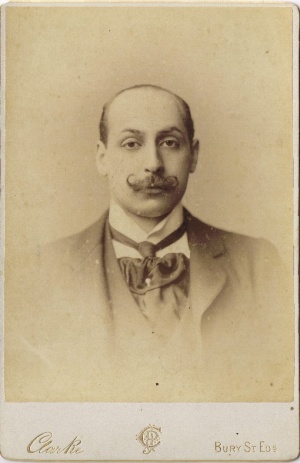Prince Fredrick
Prince Frederick was born on the 23rd January 1868, at Rutland Gate, Knightsbridge. He was baptised four months later at Elveden Church on the 2 May 1868 as Frederick Victor Jay Duleep Singh, being named after the German crown Prince, later Emperor Frederick. Prince Frederick’s education was at Eton and then Magdalene College, Cambridge. In 1890 Prince Frederick gained a Masters Degree at Cambridge in History. He was given an allowance of £2,000 from the India Office, so he could live a considerably noble life, but not an extravagant one as his fathers. In 1897 he purchased the Georgian country house, Old Buckenham Hall, but in 1906 he was house hunting again, putting the estate on the market, advertising it as a ‘A Miniature Mansion in a Miniature Park’. The sporting country mansion was auctioned by Messrs. Lumleys.[i] Who boasted ‘for its size the property affords some really excellent shooting and adjoins some of the best shootings in the county, and a large extent of sporting adjoining may be hired.’ He took temporary residence at Breckles Cottage as a tenant of Charles Bateman Hanbury, and renamed it Breckles House, forming part of the Breckles Hall estate. It was a modest house in the tiny village of Breckles, near Attleborough, compared to the grandeur of Elveden, which he was more accustomed to.
In 1909, Prince Frederick finally found the home of his dreams; the 16th Century moated Blo Norton Hall, off the main road from Thetford to Diss, His love for his beloved Blo Norton Hall inspired him to write a lengthy article in the Norfolk & Norwich Archaeological Society Journal[ii], of which he was a member. He made a chapel at the end of the attic wing at Blo Norton Hall and furnished it with old benches, hangings and other suitable ornaments, placing ancient painted glass in its windows and had it dedicated ‘to the blessed martyr, King Charles the first’. As well as being a keen collector, he was an enthusiastic archaeologist and historian.
He enrolled in the local Loyal Suffolk Hussars (Suffolk Yeomanry) in the regiment’s centenary year, and was appointed as a 2nd Lieutenant on the 12th August 1893. He was promoted to Captain in 1898 and was admitted a Member of the Royal Victorian Order (MVO) in 1901, which was designed for recognition of personal services to Queen Victoria. In the same year he transferred to the Kings Own Royal Regiment Norfolk Imperial Yeomanry, and promoted to the rank of Major.
Prince Frederick resigned his commission in 1908, but re-joined as a Major in October 1914 on the outbreak of the Great War, and was gazetted to the 2nd/1st Norfolk Yeomanry[iii] serving in France from 1917 to 1919[iv]. He spent much time with training units, and in France he was at a rest camp for artillery horses from the front where this photograph was taken and sent as a postcard to his friend Charles Partridge, the District Commissioner in Nigeria in January 1915. Here he was Area Commandant and enjoyed during the temporary illness of his devoted batman Herbert Hudson, having to clean his own boots and buttons.[v] He however sadly saw no active service.
He belonged to many historical societies and organisations, but was best associated with the Norfolk & Norwich Archaeological Society. As years passed he added to his collections, including old books, china, glass, stained glass, deeds and coins.[vi] He wrote articles for the Burlington Magazine[vii] and Connoisseur, [viii] and another seven Norfolk publications. Interested in all things Norfolk, he placed his names on many committees. He was vice-president for the ‘Suffolk Institute of Archaeology and Natural History’; ‘Fellow of the Society of Arts’; ‘Royal Norfolk Agricultural Association’ and ‘Norfolk Archaeological Trust.’
Prince Frederick was one of the founders of the ‘Pre-Historic Society of East Anglia’ and President of the ‘London Society of East Anglians,’ a committee member of the ‘Society for the Protection of Ancient Buildings,’ including the local ‘Advisory Committees for the Protection of Churches.’ Socially he was a member of London’s exclusive ‘Whites’ and ‘Carlton Club,’ and was a ‘Fellow of Society of Antiquaries (FSA).’ Whilst in the country and travelling through small villages, he would visit local parishes and churches, strongly urging them to preserve their buildings. Prince Frederick was wholly against the closure of places of worship. He encouraged the restoration of many neglected churches, such as the restoration of the old church at Thompson where he was largely responsible for persuading the Bishop of Norwich against its closure. He saved Bury Town Hall, a fine example of Adam architecture from mutilation, and took a generous interest in the repairs of the churches at Wymondham and Bradley. These being just some of the many buildings he saved. Prince Frederick was a good churchman, a rather obstinate ‘Protestant’ who disliked discussions on religion.
The local folk affectionately called him ‘Prince Freddy’ often confused with his father’s tag of ‘The Black Prince’ and his generosity was second to none, as his old friend Walter Rye quoted ‘He was never happier then when helping others[ix]’ Prince Frederick fell critically ill in 1926, his health had been in decline, but on Thursday 12th August 1926 he suffered a heart attack at his residence. His sisters immediately surrounded him and the family received a message of inquiry from the King on the Saturday. But sadly the much loved last Prince was to breath his last, and passed away at Blo Norton Hall on the 15th August at 2.30 pm on Sunday afternoon, at the age of 58.
| Family of Maharaja Duleep Singh |
|
Parents |
References
[i] Country Life, 12 May 1906
[ii] NNAS Journal, ‘Blo Norton Hall’, Volume XVIII, Part 3
[iii] The Times, 16.8.1926
[iv] Leslie Mutum
[v] EADT, 11.9.1926
[vi] The Book Collection was donated to Thetford library.
[vii] Burlington Magazine, Vol XI, 1907
[viii] ‘A County Collection,’ Connoisseur, September 1905
[ix] An Appreciation by Walter Rye, Norfolk Chronicle, 20.8.1926

